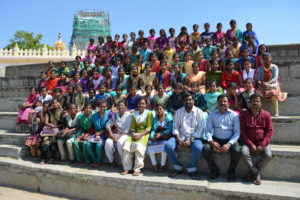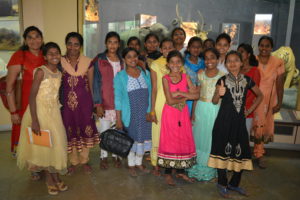 While living only an hour away from Mysore, none of our kishoris had ever been to the city. Most had never even had the opportunity to step outside their village. Even within the village, their movement is heavily restricted. Barring their schools and colleges, and a few places where adult supervision is guaranteed, girls mostly remain confined to their homes.
While living only an hour away from Mysore, none of our kishoris had ever been to the city. Most had never even had the opportunity to step outside their village. Even within the village, their movement is heavily restricted. Barring their schools and colleges, and a few places where adult supervision is guaranteed, girls mostly remain confined to their homes.
These restrictions, imposed under the garb of safety and the need to safeguard societal norms by their families, have meant that girls enjoy little to no mobility in public spaces. It is no wonder that an ardent desire to visit the ‘big city’, a place deliberately kept out of reach to them’ was articulated by them right from the beginning of our training sessions.
At Prakriye, we saw such an experience as integral to our approach to rights education of adolescent girls. Equally, we viewed this as an opportunity to engage with the girls about their right to mobility, the freedom to claim and occupy public spaces without fear, anxiety or any conditionalities. It seemed to us that the opportunity to step out, free from the problematic (if somewhat well-intentioned) surveillance of family and community, and explore the urban space would do wonders for the girls’ sense of self-discovery and mobility. It would help put in perspective the months of discussions we had had with them on unpacking gender constructs and norms, on rights and choices. Most importantly, it would allow them to have fun.
 So, the Prakriye team put together a day trip to Mysore on 5th January 2017.
So, the Prakriye team put together a day trip to Mysore on 5th January 2017.
The kishoris first visited the Regional Museum of Natural History which contains exhibits of flora, fauna and the geology of the south Indian region. Kishoris found the exhibits engaging and were able to connect what they saw and learned, with their school lessons. The museum visit was followed by a visit to the famed Chamundi temple, dedicated to the goddess Chamundi, the presiding deity of the city of Mysore.
The visit to the Mysore palace, the official residence of the Mysore Maharaja, was next on the list. The girls were taken in by the splendor of the grand architecture and the sprawling gardens of the palace.
The last stop for the day was the Saint Philomena church, one of the tallest churches in Asia and a well celebrated tourist attraction of the city, noted for its neo-gothic style of architecture. The cherry on the cake was a round of panipuris which the girls relished (most had not tried this before).
The day was a potpourri of new sights and experiences for the kishoris. When confronted with the sight of the many urban women and girls, who were all they observed amusedly, dressed in an array of fashions, moving freely about and unescorted at that, the girls showed great perspicacity in making the connection on how location could impact womens’ freedom of choice with regard to their lifestyle and mobility.
Also, the fact that they were allowed to enter both the temple and the church, and that no one questioned them at the entrance of these places of worship, was an experience that left a significant mark on the girls. In the rural communities that the girls hail from, places of worship are open only to caste Hindus, and Panchayats turn a blind eye to this practice – despite such exclusion being entirely illegal. Given this, it was liberating to them to so freely transgress the carefully bounded lines of caste and gender that govern their daily lives, even if just for a day.